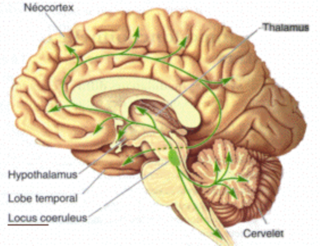Neuroscience
Two Distinct Ways the Brain Stays Focused and Curbs Impulses
Neurons in the locus coeruleus drive attentional focus and impulse control.
Posted November 6, 2020 Reviewed by Devon Frye

Accomplishing goals that require focus and grace under pressure is practically impossible if you're overexcited or easily distracted. The ability to stay laser-focused and ignore distractions while simultaneously curbing impulsiveness and not "spazzing out" is key to achieving peak performance in life and sport.
Experiencing attention deficits or being prone to impulsivity can interfere with goal-directed behavior. Additionally, attention deficits and impulsivity are also associated with various neuropsychiatric conditions such as attention-deficit/hyperactivity disorder (ADHD) and impulse control disorders.
Until recently, the neuroanatomical substrates of attentional focus and impulse control have been challenging for brain researchers to pinpoint. The good news: Recent advances in optogenetics have made it possible for neuroscientists to start zeroing in on specific brain regions and neural pathways that facilitate both attentional control and impulse control.
Previous studies in humans and mice have shown correlative evidence suggesting that norepinephrine-producing (i.e., noradrenergic) neurons in the locus coeruleus (LC) play a pivotal role in goal-directed attentional control mechanisms. However, until now, neuroscientists were unclear about how these specialized noradrenergic neurons and projecting pathways work within the brain.
A new MIT study in mice shows how norepinephrine-producing neurons in the locus coeruleus drive both attentional focus and impulse control via two distinct "noradrenergic coeruleo-frontal cortical pathways" to the prefrontal cortex. These findings (Bari et al., 2020) were published on November 2 in Proceedings of the National Academy of Sciences.
"Here we show that activation of noradrenergic neurons of the mouse locus coeruleus is necessary and sufficient for goal-directed behavior," the authors explain. "Our results reveal that the attentional control of behavior is modulated by the synergistic effects of two dissociable coeruleo-cortical pathways, with locus coeruleus projections to the dorsomedial prefrontal cortex (dmPFC) enhancing attention and LC projections to the ventrolateral orbitofrontal cortex (vlOFC) reducing impulsivity."
Through a series of elaborate mouse experiments, the MIT researchers were able to establish that stimulating LC neural connections to the dmPFC increased focus and improved correct performance but failed to reduce impulsive, premature responses. On the flip side, stimulating LC neural connections to the vlOFC didn't improve attentional focus or performance but did reduce hasty, impulsive responses. As the authors sum up:
"Here we have applied behavioral, optogenetic and neural circuit genetic techniques, which afford a high degree of temporal and cell-type specificity for the manipulation and recording of noradrenergic neuron activity in the LC and demonstrate a causal link between temporal-specific LC norepinephrine modulation and attentional control."
Previous research (Uematsu et al., 2017) into how the LC's noradrenaline system coordinates opposing learning states found that two different noradrenergic cell types in the locus coeruleus can either exacerbate "fight-flight-or-freeze" stress responses or extinguish fear. (See "The Neuroscience of Fear-Based Learning vs. Fear Extinction")
The most recent (2020) noradrenergic LC pathways research also raises some new questions about the locus coeruleus' role in curbing anxiety. In a November 2 news release, first author Andrea Bari of the RIKEN-MIT Laboratory for Neural Circuit Genetics and MIT's Picower Institute for Learning and Memory said: "To the team's surprise, stimulating LC activity also happened to reduce anxiety in the mice."
The latest locus coeruleus findings could also have implications for the treatment of attention deficit hyperactivity disorder. "ADHD patients may suffer both distractibility and impulsivity, but you can also have cases mainly characterized by inattentive presentation or by hyperactive-impulsive presentation," co-author Michele Pignatelli concluded. "Perhaps we can conceive new strategies to tackle different types of ADHD."
References
Andrea Bari, Sangyu Xu, Michele Pignatelli, Daigo Takeuchi, Jiesi Feng, Yulong Li, Susumu Tonegawa. Differential Attentional Control Mechanisms by Two Distinct Noradrenergic Coeruleo-Frontal Cortical Pathways." PNAS (First published: November 02, 2020) DOI: 10.1073/pnas.2015635117
Akira Uematsu, Bao Zhen Tan, Edgar A. Ycu, Jessica Sulkes Cuevas, Jenny Koivumaa, Felix Junyent, Eric J. Kremer, Ilana B. Witten, Karl Deisseroth & Joshua P. Johansen. "Modular Organization of the Brainstem Noradrenaline System Coordinates Opposing Learning States." Nature Neuroscience (First published: September 18, 2017) DOI: 10.1038/nn.46420
Eduardo E. Benarroch. "The Locus Ceruleus Norepinephrine System." Neurology (First published: November 16, 2009) DOI: 10.1212/WNL.0b013e3181c2937c




